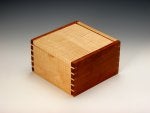Guys I was looking at Oliver's sled for making box joints and it got me thinking about whether there is any advantage between using a TS or RT for making these joints , like can one make a more accurate tighter tolerance joint?
When it comes to blind dovetail joints I suspect the routers the only option , but with box joints is it a tie, or is there less tear out or efficiency when comparing one to another etc
When it comes to blind dovetail joints I suspect the routers the only option , but with box joints is it a tie, or is there less tear out or efficiency when comparing one to another etc











